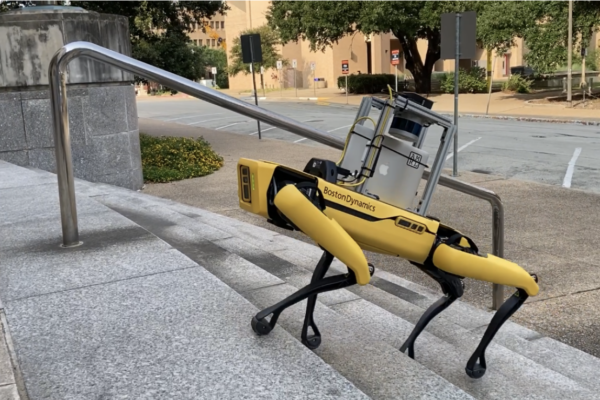AUSTIN, Texas — Autonomous robots will soon rove the buildings and streets of The University of Texas at Austin campus. But unlike other commercial delivery services, this fleet of robots will help researchers understand and improve the experience of pedestrians who encounter them.
A new grant to an interdisciplinary team of researchers at UT Austin will support the creation of a robot delivery network on campus, with the first deployments scheduled for early 2023. The researchers plan a five-year study focusing on what it takes to create, safely operate and maintain this kind of robot network, while also adapting with the humans who live and work around it.
The team’s research promises to become the most extensive data about human-robot encounters in public spaces to date. Over time, the team will learn how state-of-the-art robotic autonomy and a real-world community can best co-exist.
“Robotic systems are becoming more ubiquitous,” said Luis Sentis, a professor in the Cockrell School of Engineering’s Department of Aerospace Engineering and Engineering Mechanics and leader of the project. “In addition to programming robots to perform a realistic task such as delivering supplies, we will be able to gather observations to help develop standards for safety, communication and behavior to allow these future systems to be useful and safe in our community.”

When the network is up and running, members of the UT Austin community will be able to order free supplies such as wipes and hand sanitizer via a smartphone app. The robots will deliver them to certain pedestrian zones on campus, door-to-door.
As they do, the robots will encounter potentially hundreds of pedestrians. The researchers want to understand what kinds of behaviors and interactions are expected from the robots during these encounters, while ensuring their tasks are successfully completed.
The researchers study human-AI partnerships through the Good Systems research grand challenge. The new $3.6 million grant from the National Science Foundation expands on their six-year project Living and Working with Robots, which kicked off in September 2021.
The researchers plan to use two different types of dog-like robots made by Boston Dynamics and Unitree. In later phases of the research, the robots will go out in teams of two, monitored both by chaperones and people remotely. This means researchers will always have the ability to stop the robots if necessary.
The team will study ways to improve oversight for a fleet of robots. Nanshu Lu, a professor in the Department of Aerospace Engineering and Engineering Mechanics, will design wearable brain sensors to be placed on the people monitoring the robots to understand the kind of workload and attention span this would require.
The researchers expect to gain insights from observing and interviewing people who encounter the robots in a variety of contexts. Importantly, the team knows reactions will vary widely and wants to develop tools for understanding the full range of experiences encountering robots on campus can produce. This work could help designers figure out how future public-facing robots should be designed to co-exist within diverse communities like UT Austin’s, as well as how and where they should move.
Elliott Hauser, an assistant professor in the School of Information, will lead the development of a shared research database that will collect and relate the many types of data the team and its robots will generate. Justin Hart, an assistant professor of practice with the College of Natural Sciences, is leading human-robot interactions in the community. Keri Stephens, a professor in the Moody College of Communication, is leading team science efforts. Joydeep Biswas, assistant professor of computer science in the College of Natural Sciences, is leading robot navigation in social environments. Junfeng Jiao of the School of Architecture will research how urban informatics and smart cities research can inform the deploying robots in social environments. Maria Esteva of the Texas Advanced Computing Center is leading the development of the project’s convergent data model. Samantha Shorey, assistant professor of communication studies in the Moody College of Communication, is leading the group’s work on ethnographic studies of the community and the research team itself.




